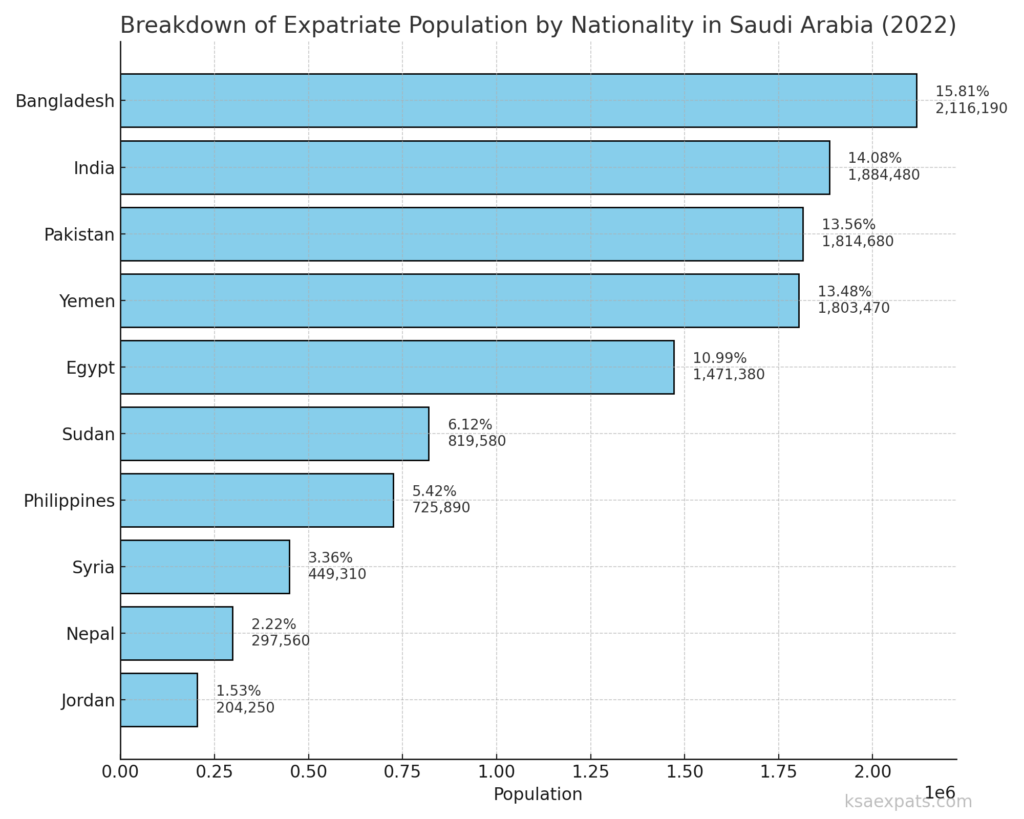
Saudi Arabia’s Population in 2024: A Detailed Analysis of Expatriates and Nationalities
Saudi Arabia, a country known for its vast deserts, historical sites, and economic prowess, has a population that reflects its importance in the global arena. As of August 2024, Saudi Arabia’s total population stands at approximately around 37.5 million. This figure includes both Saudi nationals and a substantial number of expatriates, who play a crucial role in the country’s development.
Overall Population Overview
The total population of Saudi Arabia, estimated at around 37.5 million in 2024, has been growing steadily at a rate of about 1.43% per year. This growth is a result of both natural population increase and the continued influx of expatriates, who constitute a significant portion of the population.
Expatriate Population in Saudi Arabia
Expatriates make up around 35% of Saudi Arabia’s population, amounting to approximately 13 million people. These expatriates come from diverse countries, contributing to the country’s labor force, cultural diversity, and economic growth. The expatriate community in Saudi Arabia is not homogenous; it is comprised of individuals from various nations, each with its own cultural and professional background.

Breakdown of Expatriate Population by Nationality (Based on 2022 Census Data)
According to the 2022 Saudi census, the expatriate population in Saudi Arabia is dominated by individuals from a few key countries. The following are the largest expatriate groups by nationality:
1. Bangladesh
- Population: 2,116,190
- Percentage of Total Foreigners: 15.81%
Bangladeshis form the largest expatriate community in Saudi Arabia. They are heavily employed in sectors such as construction, domestic work, and various service industries.
2. India
- Population: 1,884,480
- Percentage of Total Foreigners: 14.08%
The Indian community is one of the most significant expatriate groups, contributing to a wide range of sectors including IT, healthcare, construction, and finance.
3. Pakistan
- Population: 1,814,680
- Percentage of Total Foreigners: 13.56%
Pakistanis in Saudi Arabia are primarily involved in construction, transportation, and retail industries.
4. Yemen
- Population: 1,803,470
- Percentage of Total Foreigners: 13.48%
Yemeni expatriates are prevalent in retail, construction, and various entrepreneurial ventures.
5. Egypt
- Population: 1,471,380
- Percentage of Total Foreigners: 10.99%
Egyptians in Saudi Arabia work across multiple sectors, including education, healthcare, and engineering.
6. Sudan
- Population: 819,580
- Percentage of Total Foreigners: 6.12%
The Sudanese community is involved in education, healthcare, and various technical fields.
7. Philippines
- Population: 725,890
- Percentage of Total Foreigners: 5.42%
Filipinos are prominent in the healthcare sector, hospitality, and domestic work.
8. Syria
- Population: 449,310
- Percentage of Total Foreigners: 3.36%
Syrians in Saudi Arabia work in sectors such as education, healthcare, and small businesses.
9. Nepal
- Population: 297,560
- Percentage of Total Foreigners: 2.22%
Nepalese expatriates are mainly employed in construction, security, and domestic work.
10. Jordan
- Population: 204,250
- Percentage of Total Foreigners: 1.53%
Jordanians in Saudi Arabia contribute to sectors such as education, finance, and engineering.

The Role of Expatriates in Saudi Arabia’s Economy
The expatriate population is vital to Saudi Arabia’s economy. They provide the necessary labor force in key industries such as construction, healthcare, and domestic services, supporting the country’s rapid development. Moreover, expatriates contribute to the cultural diversity within the Kingdom, bringing different perspectives and experiences that enrich Saudi society.
Saudi Arabia’s Vision 2030 aims to reduce the country’s dependency on oil by diversifying its economy. As part of this vision, the government is working on creating more employment opportunities for Saudi nationals while maintaining the essential contributions of expatriates in the workforce.
Future Demographic Trends
As Saudi Arabia continues to implement its Vision 2030 initiatives, the demographic landscape is expected to evolve. While the expatriate population may adjust in response to new labor policies and economic shifts, they will continue to be a key part of the Kingdom’s growth and development.
In conclusion, Saudi Arabia’s population is a dynamic blend of Saudi nationals and expatriates, each contributing significantly to the nation’s economy and cultural fabric. Understanding the composition and role of this population is crucial for anyone engaged in the Kingdom’s economic and social spheres.
Amazon White Friday Offers
- 📱 38% discount on the Samsung Galaxy S24 Ultra phone, 256 GB storage
- 📱 24% discount on iPhone 15 Pro (1 TB) - Titanium Blue
- 📱 26% discount on Samsung Galaxy Z Fold6, 12 GB RAM, 256 GB storage - Pink
- ☕ 59% discount on the coffee maker Black+Decker, 900 W, serves up to 12 cups
- 🍳 56% discount on the Edson air fryer, 22 liters, 1900 W - White
- 🍳 49% discount on the Nutricook Vision air fryer, 5.7 liters, equipped with a transparent window and internal lighting
- 💻 33% discount on Apple MacBook Air, 2022 model, M2 chip
- 💻 24% discount on HP laptop, Model 15-fd0000nx, 15.6” FHD screen, Intel Core i7 processor
- 💻 14% discount on Apple MacBook Pro 2023 (M3 Max chip)